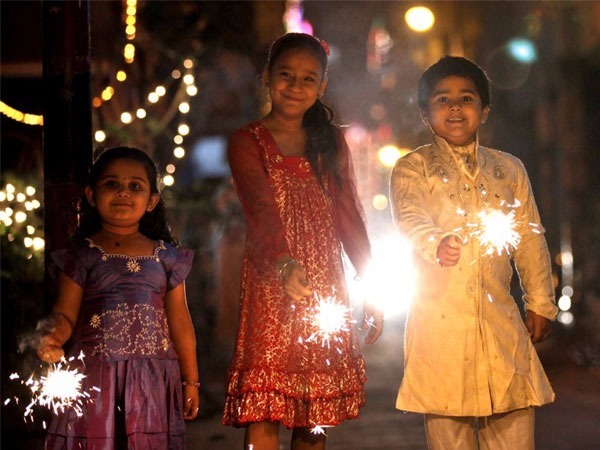
From Dhanteras to Bhai Dhooj: How is Diwali celebrated across India?
23 Oct 2016 | 5 min Read
Anshu Bhojnagarwala (firsttimemommy)
Author | 67 Articles
Sometimes, the best stories to tell children are all around us. Let’s take Diwali, for example. This 5-day long festival is celebrated in so many different ways in different regions – offering a story each.
This year, I gathered more details to tell these beautiful stories about our culture to my daughter. See if you would like to pick them up too!

In Maharashtra, just before Diwali, people get busy with making ‘pharal’ – a variety of sweets, laddoos, snacks and savouries in the house. The children make little forts out of mud, cow dung and wheatgrass which are then decorated.
These forts represent the many forts of Chhatrapati Shivaji Maharaj, the legendary and most beloved icon of Marathwada. That was about Maharashtra. Now won’t it be interesting for your kids to know how Diwali is celebrated in other parts of India?

Dhanteras: For most Indian communities, the festival of Diwali begins with Dhanteras, or the day when Lakshmi, the goddess of wealth, is worshipped. It is customary to purchase silver or gold on this day.
Chhoti Diwali: The day before Diwali is also called Naraka Chaturdashi and Kali Chaudas. In the south of India, this is considered the most important day. Families wake up at dawn, apply aromatic oils on their bodies before taking a bath. It is believed that these special oils remove all sins and impurities.
It is said that on Naraka Chaturdashi when Lord Krishna returned home after killing the demon Narakasura, the womenfolk of the house massaged him with scented oils. This was done so as to purge his body of any residual filth from his encounter with the demon.
The house is then cleaned and decorated with rangoli patterns. After pooja, they partake in a heavy breakfast and snacks comprising of murukku and other sweets. In the evening, diyas are lit and crackers are burst.
Bengalis light 14 lamps on this day which is also known as, ‘Bhoot Chaturdashi’. These 14 diyas are said to ward off evil spirits. Some say they are for the 14 generations of ancestors whose spirits visit the mortal world on this night.

Diwali: This is the main day of the festival for most Hindus. On this day, Lakshmi Puja is performed in offices, factories and homes. From the morning, the entire household is busy with the frenzy of the celebrations. People perform the puja at an auspicious time – the mahurat. Hymns are sung in praise of Goddess Lakshmi, urging her to bestow prosperity on the household.
Many businesses start their next financial year on Diwali day and this is symbolised by buying a new ledger book. ‘Om’ and ‘Sathya’ are drawn over it. After the pooja, people distribute sweets and gifts to employees, light diyas and burst crackers.
Some communities of Rajasthan, Haryana, Punjab and UP keep an ‘akhand diya’ through the night of Diwali. The elders of the family do not let the lamp extinguish and keep adding more ghee or oil to the lamp till the morning.

While most people worship Goddess Lakshmi on Diwali, Bengalis worship Goddess Kali on this day. Goddess Kali was born out of the forehead of Goddess Durga, to slay the demons Sumbho and Nishumbho who were terrorizing earth and heaven.
Kali puja takes place at midnight on the no-moon night in the month of Kartik, which is the Diwali day. She is evoked to protect her children from the many calamities that plague the world.

Govardhan Pooja or Padva: It is said that it was on this day that Lord Krishna defeated God Indra by lifting the huge mountain of Govardhan. The people of North India build a small hillock using cow dung symbolizing the mountain and then worship it. They prepare ‘annakut’ which translates as, ‘a mountain of food’ and offer this elaborate meal to Lord Krishna.
This day is new year’s day for Gujaratis. They wear new clothes, visit temples, friends and family. Also, early in the morning, raw salt, known as ‘sabras’ is bought. Sabras means ‘all taste’, as salt is the most important ingredient in cooking.

Bhai Dooj: The fifth and the last day of the Diwali is celebrated as Bhai Dooj (North India), Bhau Beej (Maharashtra) or Bhai Phota (Bengal). On this day, sisters invite their brothers to their homes for a lavish feast. They first apply a tikka of vermillion on their forehead, offer them sweets and pray for their long and prosperous life. The exchange of gifts among the siblings makes it even more awaited and memorable at the same time.
According to a legend, if brothers and sisters take a dip together in the holy river of Yamuna, their love for each other will sustain through death and reincarnations.
Diwali may be celebrated in several ways across India but the essence of the festival is the same – to bring families closer while ringing in new beginnings.
Explore the entire collection of articles: Diwali
If you are reading this article on our website and have an Android phone, please download our APP here for a more personalised experience based on your lifestage.
A


Suggestions offered by doctors on BabyChakra are of advisory nature i.e., for educational and informational purposes only. Content posted on, created for, or compiled by BabyChakra is not intended or designed to replace your doctor's independent judgment about any symptom, condition, or the appropriateness or risks of a procedure or treatment for a given person.
